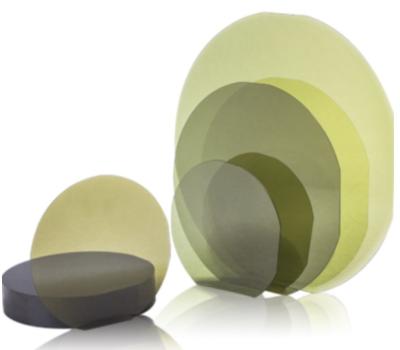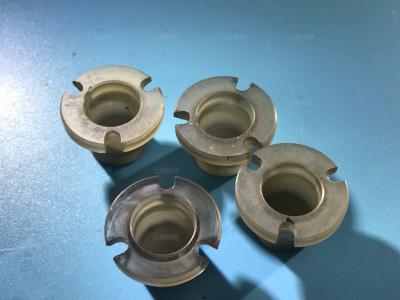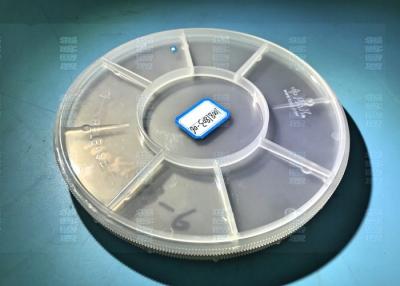





| Price | Negotiable |
| MOQ | 5 |
| Delivery Time | 2-4 weeks |
| Brand | ZMSH |
| Place of Origin | China |
| Model Number | Semi-Insulating SiC |
| Payment Terms | T/T |
| Place of Origin | China | Primary flat orientation | <11-20>+5.0° |
| BOW | <25um | Model Number | Semi-Insulating SiC |
| Usable area | ≥ 90 % | Brand Name | ZMSH |
| Payment Terms | T/T | Surface Roughness | 0.5 nm (Si-face CMP Epi-ready) |
| Delivery Time | 2-4 weeks | Minimum Order Quantity | 5 |
| Resistivity (RT) Surface Roughness | >1E5 Ω.cm | FWHM | A<30 arcsec |
| TTV | <25um | Polytype | 4H 6H |
| Surface Finish | Single or double face polished | warp | <25um |
The
4-H
Semi-Insulating
SiC
substrate
is
a
high-performance
semiconductor
material
with
a
wide
range
of
applications.
It
derives
its
name
from
its
growth
on
the
4H
crystal
structure.
This
substrate
exhibits
exceptional
electrical
characteristics,
including
high
resistivity
and
low
carrier
concentration,
making
it
an
ideal
choice
for
radio
frequency
(RF),
microwave,
and
power
electronic
devices.
Key
features
of
the
4-H
Semi-Insulating
SiC
substrate
include
highly
uniform
electrical
properties,
low
impurity
concentration,
and
outstanding
thermal
stability.
These
attributes
make
it
suitable
for
the
fabrication
of
high-frequency
RF
power
devices,
high-temperature
electronic
sensors,
and
microwave
electronic
equipment.
Its
high
breakdown
field
strength
and
excellent
thermal
conductivity
also
position
it
as
the
preferred
substrate
for
high-power
devices.
Furthermore,
the
4-H
Semi-Insulating
SiC
substrate
demonstrates
excellent
chemical
stability,
allowing
it
to
operate
in
corrosive
environments
and
expanding
its
range
of
applications.
It
plays
a
critical
role
in
industries
such
as
semiconductor
manufacturing,
telecommunications,
defense,
and
high-energy
physics
experiments.
In
summary,
the
4-H
Semi-Insulating
SiC
substrate,
with
its
outstanding
electrical
and
thermal
properties,
holds
significant
promise
in
the
semiconductor
field
and
provides
a
reliable
foundation
for
the
production
of
high-performance
electronic
devices.
High-Power
Electronic
Devices:
Semi-Insulating
SiC
is
ideal
for
high-power
and
high-frequency
electronic
devices
due
to
its
high
breakdown
voltage
and
high
thermal
conductivity.
It
is
used
in
power
MOSFETs,
diodes,
and
IGBT
RF
Devices:
Due
to
its
high
thermal
conductivity
and
low
loss,
Semi-Insulating
SiC
is
employed
in
RF
devices
such
as
microwave
power
amplifiers
and
RF
transistors.
Optoelectronic
Devices:
Semi-Insulating
SiC
also
exhibits
excellent
optoelectronic
properties,
making
it
suitable
for
manufacturing
LEDs,
lasers,
and
photodetectors.
Electronic
Devices
in
High-Temperature
Environments:
The
material's
high
melting
point
and
excellent
chemical
stability
make
Semi-Insulating
SiC
widely
used
in
electronic
devices
that
operate
in
high-temperature
environments,
such
as
in
aerospace,
automotive,
and
industrial
process
control.
Radiation-Hardened
Devices:
Semi-Insulating
SiC
is
highly
resistant
to
radiation,
making
it
suitable
for
radiation-hardened
electronic
devices
in
nuclear
reactors
and
space
applications.
Sensors:
The
unique
properties
of
Semi-Insulating
SiC
material
make
it
suitable
for
manufacturing
various
types
of
sensors,
such
as
temperature
sensors,
pressure
sensors,
and
chemical
sensors.
High
Resistivity:
Semi-Insulating
SiC
possesses
very
high
resistivity,
meaning
it
can
effectively
impede
the
flow
of
electric
current,
making
it
suitable
for
use
as
an
insulating
layer
in
high-power
electronic
devices
High
Thermal
Conductivity:
SiC
material
has
a
very
high
thermal
conductivity,
which
helps
in
quickly
and
efficiently
dissipating
heat
from
devices,
thereby
enhancing
device
performance
and
reliability.
High
Breakdown
Voltage:
Semi-Insulating
SiC
has
a
very
high
breakdown
voltage,
meaning
it
can
operate
in
high-voltage
applications
without
experiencing
electrical
breakdown.
Excellent
Chemical
Stability:
SiC
remains
chemically
stable
across
a
wide
range
of
temperatures
and
is
highly
resistant
to
most
acids
and
bases.
High
Melting
Point:
SiC
has
an
exceptionally
high
melting
point,
approximately
2,730°C
(4,946°F),
allowing
it
to
maintain
stability
in
extreme
high-temperature
environments.
Radiation
Tolerance:
Semi-Insulating
SiC
exhibits
high
tolerance
to
radiation,
making
it
perform
excellently
in
nuclear
reactor
and
space
applications.
Excellent
Mechanical
Properties:
SiC
is
a
very
hard
material,
showcasing
excellent
wear
resistance
and
high
strength.
Wide
Bandgap
Semiconductor:
SiC
is
a
wide
bandgap
semiconductor,
featuring
high
electron
mobility
and
low
leakage
current,
which
results
in
outstanding
performance
in
high-temperature
and
high-frequency
electronic
devices.
| Property | Description |
| High Resistivity | Possesses very high electrical resistivity, acting as an effective insulator in high-power electronic devices. |
| High Thermal Conductivity | Quickly and efficiently dissipates heat, enhancing device performance and reliability. |
| High Breakdown Voltage | Can operate under high-voltage conditions without undergoing electrical breakdown. |
| Excellent Chemical Stability | Remains stable across a wide range of temperatures and is highly resistant to most acids and bases. |
| High Melting Point | Maintains stability in extreme high-temperature environments with a melting point around 2,730掳C (4,946掳F). |
| Radiation Tolerance | Exhibits high resistance to radiation, suitable for use in nuclear reactors and space applications. |
| Excellent Mechanical Properties | Very hard material, providing outstanding wear resistance and high strength. |
| Wide Bandgap Semiconductor | Functions well in high-temperature and high-frequency applications due to high electron mobility and low leakage current. |

Silicon Carbide (SiC) Wafers are thin slices of semiconductor material primarily used for power electronics. To ensure the wafers are not damaged during shipping, it’s important to follow the proper packaging and shipping instructions.



